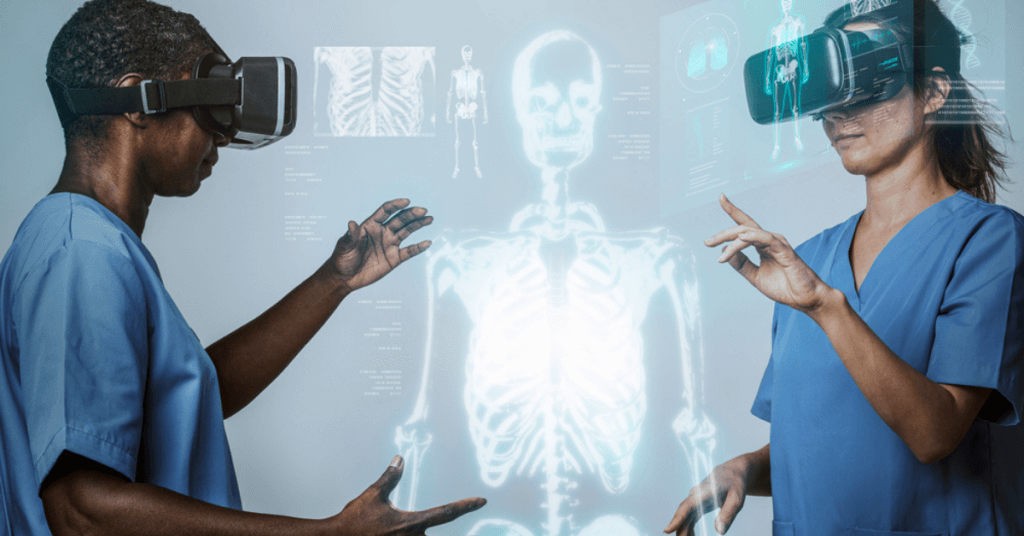Augmented Reality (AR) and Virtual Reality (VR) have revolutionized multiple industries, enhancing user experiences and providing innovative solutions to real-world challenges. Among the most impacted sectors are gaming, healthcare, and education. AR and VR technologies offer immersive, interactive, and engaging experiences, transforming traditional approaches and opening new possibilities for users. This article explores how AR and VR applications are reshaping these three sectors.
AR/VR in Gaming
Gaming has been one of the earliest adopters of AR and VR technologies, leveraging their capabilities to create more immersive and engaging experiences.
- Enhanced Immersion: VR headsets like Oculus Quest and PlayStation VR transport players into a virtual world, providing an immersive experience where they can interact with digital environments in real-time. This technology allows for an unprecedented level of realism in gaming.
- Augmented Reality in Mobile Gaming: AR has gained significant popularity through mobile applications. Games like Pokémon GO and Harry Potter: Wizards Unite integrate digital objects into the real world using AR, encouraging players to explore their surroundings and interact with virtual elements in their real environment.
- Haptic Feedback and Motion Tracking: Advanced gaming setups now include haptic feedback devices, such as gloves and vests, that provide tactile sensations. Motion tracking systems allow players to use body movements for in-game interactions, enhancing realism and engagement.
- Social and Multiplayer Interaction: VR-based games enable players to interact with each other in a shared virtual space. Platforms like VRChat and Rec Room allow users to socialize, collaborate, and play games together, fostering a sense of community in the digital world.
AR and VR are continuously evolving, promising even more lifelike graphics, better controls, and seamless integration with real-world environments. The gaming industry is set to benefit from these advancements, making gaming experiences more immersive and interactive than ever before.
AR/VR in Healthcare
The healthcare industry has witnessed significant advancements with the integration of AR and VR, improving patient care, medical training, and treatment methodologies.
- Medical Training and Education: VR is being extensively used in medical schools and training centers to simulate real-life surgical procedures. Platforms like Osso VR and Touch Surgery allow medical students and professionals to practice complex surgeries in a risk-free virtual environment.
- Pain Management and Therapy: VR has been effectively used as a distraction tool to reduce pain perception in patients undergoing painful treatments such as burn wound care and chemotherapy. Virtual environments help divert the patient’s attention, minimizing discomfort.
- Enhanced Diagnosis and Treatment Planning: AR is helping doctors visualize complex medical conditions. Tools like AccuVein assist in locating veins for injections, while AR-enabled imaging solutions help in diagnosing and planning surgeries with greater accuracy.
- Mental Health Treatment: VR therapy is being increasingly used for treating conditions like PTSD, anxiety, and phobias. Controlled virtual environments expose patients to their fears in a gradual and safe manner, helping them overcome psychological challenges.
- Physical Rehabilitation: VR-based rehabilitation programs assist patients recovering from strokes or injuries. By engaging them in interactive exercises within a virtual environment, VR helps improve motor skills and cognitive functions more effectively than traditional therapy.
The integration of AR and VR in healthcare is making medical procedures safer, improving training quality, and offering better therapeutic solutions. These advancements are paving the way for a more efficient and patient-centered healthcare system.
AR/VR in Education
Education is another sector where AR and VR are making a significant impact. Traditional learning methods are being transformed into interactive and experiential learning experiences.
- Immersive Learning Environments: VR allows students to explore historical sites, outer space, and underwater ecosystems without leaving the classroom. Platforms like Google Expeditions offer virtual field trips, enabling students to experience subjects in an engaging and realistic way.
- Enhanced Understanding of Complex Concepts: AR applications help students visualize difficult subjects such as human anatomy, physics, and chemistry. By overlaying digital information onto physical objects, AR enhances comprehension and retention of knowledge.
- Medical and Engineering Training: Just as VR aids medical professionals, engineering students benefit from virtual simulations of machinery and complex engineering structures. This hands-on approach enables better understanding and practical learning without the need for expensive physical models.
- Language Learning and Communication Skills: AR and VR platforms, such as Mondly VR, provide immersive language-learning experiences by simulating real-life conversations and environments. This helps learners practice languages in a more interactive and engaging manner.
- Inclusive Learning for Students with Disabilities: VR and AR technologies are being used to create customized learning experiences for students with disabilities. VR-based applications assist students with autism in social skills training, while AR tools help visually impaired learners by providing audio descriptions of their surroundings.
The integration of AR and VR in education is fostering a more interactive, engaging, and effective learning process. By offering personalized learning experiences, these technologies are making education more accessible and inclusive.
Conclusion
AR and VR have emerged as transformative technologies, significantly impacting gaming, healthcare, and education. In gaming, they create more immersive and interactive experiences. In healthcare, they improve patient care, medical training, and treatment effectiveness. In education, they make learning more engaging and accessible. As AR and VR technologies continue to evolve, their applications will expand further, enhancing various industries and improving the way we experience and interact with the digital and physical worlds. The future of AR and VR is promising, with endless possibilities for innovation and advancement.
Cassia Rowley is the mastermind behind advertising at The Bad Pod. She blends creativity with strategy to make sure ads on our site do more than just show up—they spark interest and make connections. Cassia turns simple ad placements into engaging experiences that mesh seamlessly with our content, truly capturing the attention of our audience.


